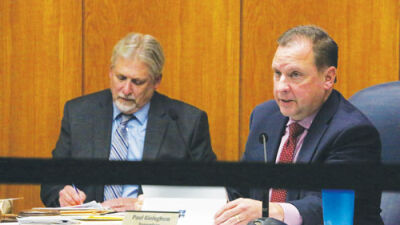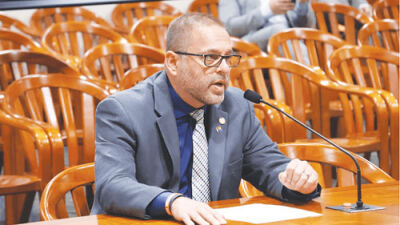HARRISON TOWNSHIP — A disposal site for dredging projects will receive upgrades with the help of $500,000 in federal funds.
On April 22, U.S. Rep. John James, R-Shelby Township, and Macomb County Public Works Commissioner Candice Miller held a press conference outside the Mount Clemens field office of the Michigan Department of Natural Resources to announce the funding.
“These are your tax dollars, and we’re spending them to keep our crown jewel, our Lake St. Clair, our Great Lakes and Clinton River clean,” James said. “This is extremely important for our environment, extremely important for our future, extremely important for our economy and our enjoyment.”
According to Brandon Hubbard, spokesperson for the Army Corps of Engineers, work at the DNR site is expected to begin this spring.
“What we’re going to do with that is essentially vegetation and tree removal between the dike and perimeter fence, and then we’re going to do some restoration of a gravel dike access road,” Hubbard said.
The Clinton River Confined Disposal Facility is a 30-acre site in Harrison Township. Constructed in 1979, the facility is used to store sediment from the Clinton River that is too contaminated to be reused. It currently has a capacity of 370,000 cubic yards and receives about 20,000 cubic yards of sediment from the river every three to five years, according to a document from the Army Corps of Engineers. Prior to the work being done, the Army Corps of Engineers estimated the facility had five more years before becoming unusable.
Hubbard said the work will take about a year to complete. Once completed and if funding is approved, further dredging of the Clinton River could begin in summer 2025.
“These are really important projects,” Hubbard said. “It’s one of the locations that is central to the Detroit area and this project allows us to do the dredging there, which in turn allows us to ensure there’s safe navigation in the Clinton River. It’s an important part of what the Army Corps does here at the Detroit District.”
Numerous officials and organizations echoed Hubbard’s sentiments about the site’s importance.
“The Clinton River is probably, outside of the Detroit River and the St. Clair River and the St. Mary’s (River), the busiest waterway in the state of Michigan; one of the busiest in the entire country,” Miller said.
Steve Remias, president of Macray Harbor in Harrison Township and a consultant to the Macomb County Chamber, stated that 1.4 million people annually use the Clinton River and Lake St. Clair, 18,000 of which rely on the waterways for jobs.
“We’re talking about how on the coastline there’s 80 public launches, 20,000 boat slips, 10 public parks, 62 marinas,” Remias said.
The Clinton River’s environmental importance was emphasized by Jennifer Hill, executive director of the Clinton River Watershed Council.
The Clinton River was designated as an Area of Concern by the Environmental Protection Agency under the 1987 Great Lakes Water Quality Agreement. Pollutants that have been found in the river include heavy metals and polychlorinated biphenyls, a carcinogenic chemical used in carbonless copy paper and coolants. Work to clean up the river and restore wildlife habitats along it has been ongoing since 1988. The EPA’s remedial action plan for the river was last revised in 2014.
According to Hill, a study by the DNR in the 1960s found no living fish in the river between Pontiac and Lake St. Clair. A recent study by the DNR found 80 fish species in the river.
“Today the Clinton River is a state-designated water trail,” Hill said. “It’s a place where people come to paddle, where they come for reactionary fishing opportunities and, of course, to boat as well, and it supports a vital economy in this area. But we know the fight to improve the health of the Clinton River is not over unfortunately, and we know we’ve had an underinvestment in our aging infrastructure here in Michigan. We need to invest in that infrastructure not only for the economy, but for the recreational uses that folks use the river and Lake St. Clair for.”
 Publication select ▼
Publication select ▼



















